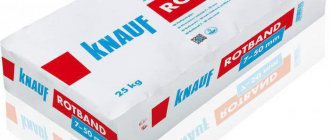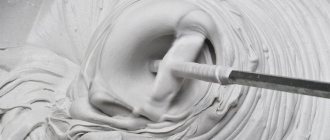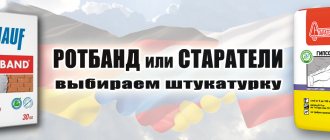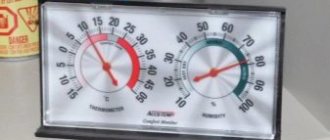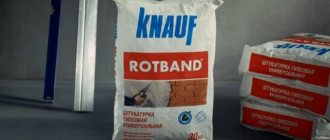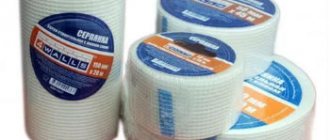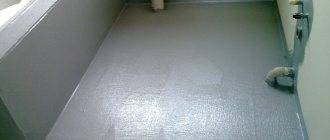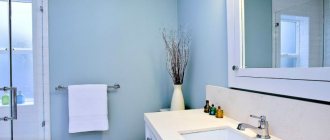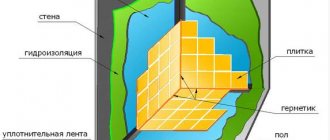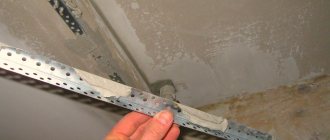Rotband plaster what is it?
Rotband is a universal dry plaster mixture based on gypsum binder with light filler (perlite or sand is most often used) and polymer additives that provide increased adhesion. Rotband has been produced worldwide since 1962, in Russia since 1997.
It is standardly produced in paper bags of 30 kg, and also comes in small packaging of 5 and 10 kg.
This is a hand applied mixture for interior use. A direct analogue for mechanized application is Knauf MP75 (Knauf MP75).
Padding
- To avoid uneven setting of the solution, the surfaces to be plastered are treated with KNAUF-Mittelgrund primer diluted with water in a ratio of 1:3, or KNAUF-Multigrund primer. Masonry made of sand-lime brick and gas-foam concrete blocks is primed with KNAUF-Mittelgrund, diluted with water in a ratio of 1:4 and 1:5, respectively, or KNAUF-Multigrund. Dense, smooth, weakly absorbent and non-moisture-absorbing surfaces, for example, concrete, cement plasters, tongue-and-groove and polystyrene foam boards, are treated with KNAUF-Betokontakt or KNAUF-Betogrund primer to improve the adhesion (adhesion) of the plaster to the surface. After application, allow the primer to dry: KNAUF-Mittelgrund and KNAUF-Multigrund - 6 hours, KNAUF-Betokontakt - 12 hours, KNAUF-Betogrund - 2 hours.
- Avoid dusting the primed surface.
- Knauf does not guarantee the quality and durability of the resulting surface when using primers from other manufacturers.
Installation of beacon profiles
Apply KNAUF-Rotband mortar mixture in small portions to the surface of the base after 30 cm, into which press the beacon profiles, aligning them in the same plane. The profile pitch should not exceed the length of the rule.
Installation of protective corner profiles
Apply the KNAUF-Rotband mortar mixture in small portions to the inside of the corner profiles in increments of 30 cm. Place the profiles on the corners in the same plane as the beacon profiles, pressing each from the middle to the edges.
Preparation of plaster mortar
Pour the contents of the bag (30 kg) into a container with 18 liters of clean cold water. Mix with a construction mixer until a homogeneous mass is formed. If necessary, add water until the required consistency is obtained and mix again. Leave for 5 minutes and stir again. During the process of preparing and applying the solution to the surface to be plastered, you cannot add dry mixture to the tank! It is not allowed to introduce other components into the solution!
Applying plaster mortar
Apply the prepared plaster solution to a surface 5–50 mm thick within 20–25 minutes after mixing. The solution should be applied to the ceiling with a plaster trowel “on itself”, on the wall - applied with a trowel or spread with a plaster trowel from bottom to top, and then leveled using the h-rule using zigzag movements. Bases made of CBPB and expanded polystyrene should be plastered with reinforcement over the entire surface with fiberglass mesh with cells of 5 by 5 mm. Mesh consumption is approximately 1.2 sq. m per sq. m of surface (including overlap).
Layer thickness
- The recommended average thickness of the plaster layer is 10 mm, the minimum is 5 mm. A single-layer application of the solution in a layer up to 50 mm thick is allowed, however, in this case, the drying time of the plaster layer for subsequent finishing increases significantly. To reduce drying time, apply the solution in two steps. First, a layer 35 mm thick is applied, which, while still soft, needs to be “combed” in waves with a plaster comb and only after this layer has dried, treated with KNAUF-Mittelgrund primer, diluted with water in a ratio of 1:3. After the primer has dried (min. 6 hours), apply a second layer of plaster. Plaster ceilings only in one layer with a thickness of no more than 15 mm.
- The minimum thickness of the plaster layer for gluing ceramic tiles is 10 mm.
Leveling the surface
As soon as the plaster solution begins to set (approximately 45–60 minutes after mixing), level the surface with a metal trapezoidal lath or a wide metal spatula, cutting off excess and filling the recesses. Cut off uneven areas in corners and slopes with a plaster plane. After drying, ceramic tiles can be glued to such a surface using KNAUF-Fliesen glue, having previously treated the surface with a KNAUF-Tiefengrund deep penetration primer. In places where the tiles come into direct contact with water, it is necessary to apply KNAUF-Flachendicht waterproofing. For tiling over waterproofing, glue is used: KNAUF - Flizen Plus, KNAUF-Flex, KNAUF-Marble.
How long does it take for Rotband to dry?
Drying of plaster depends on many factors, but on average the drying time of a layer of 15-20mm at a temperature of 20C and air humidity of about 60% is approximately 7 days.
For quick drying, it is necessary to ensure good ventilation and absence of drafts in the room. Do not point the heat gun at the plastered surface, as this may lead to defects.
To speed up drying, you can use dehumidifiers that condense moisture from the surrounding air.
Wallpaper for gypsum plaster
Gypsum plaster
The gypsum mass is distinguished by its convenience, plasticity, uniformity, and the absence of rough impurities, so even thin non-woven wallpaper can be glued to Rotband.
But can you rub the surface to make it perfect? This is a job for a master.
Experts advise gluing wallpaper after finishing putty or after Rotband finish plaster.
Professionals, when asked whether it is possible to glue wallpaper on Rotband, answer that it is possible. Provided the walls are perfect. If you expect to get smooth surfaces, or if you want to do without a finishing agent, then putty, sand, prime. And be sure to pay attention to the quality of the wallpaper.
Rotband color
Rotband in Russia is produced at several factories. On each bag, after the date and time of production, a digital code of the manufacturer is indicated. Depending on the presence of various natural impurities in the raw material (natural gypsum), the color of the plaster may vary.
Letter designation of the manufacturing plant:
- A - Knauf Gips Krasnogorsk LLC, Moscow - gray mixture;
- B - Knauf Gips Kolpino LLC, St. Petersburg - gray mixture;
- C - Knauf Gips Kuban LLC, Krasnodar - light (white) mixture;
- D - Knauf Gips Baskunchak LLC, Astrakhan - light (white) mixture;
- E - Knauf Gips Chelyabinsk LLC, Chelyabinsk - light (white) mixture;
- F - Knauf Gips Baikal LLC, Irkutsk - gray mixture;
- G - Knauf Gips Chelyabinsk LLC, Samara - gray mixture;
- H - Zvenigovsky Construction Gypsum Plant LLC, rep. Mari El - gray mixture;
- I - Knauf Gips Novomoskovsk LLC, Tula - gray mixture.
Instructions for use
Rotband is a gypsum-based plaster from the Knauf brand. The composition includes high-strength gypsum and minerals that are used for strengthening. The product is produced in paper bags in dry form.
Rating of popular dry mixtures for plastering walls.
Before use, the plaster must be diluted with water to obtain a mixture for surface treatment. It is important to maintain the proportions and stir until smooth so that there are no lumps, otherwise when puttingtying the walls or ceiling the material will lie unevenly.
General average characteristics | |
| Mixture base | plaster |
| Layer thickness | 5-50 mm |
| Purpose | interior work (ceiling, floor, for painting) |
| Base material | concrete, cement plaster, foam aerated concrete blocks, etc. |
| Water consumption (per 1 kg) | 0.6 l |
| Grain size | 1.2 mm |
| Mixture consumption for a layer of 10 mm | 8.5 kg per sq. m |
Rotband plaster has established itself as one of the best for interior and exterior work. It has a number of advantages:
- Eco-friendly and hypoallergenic. The basis of plaster is gypsum, which is a natural material, and not a mixture of chemicals.
- Prostate at work. The material is easy to stir, it lays flat and does not flow. It can be used not only by professionals, but also by beginners.
- Versatility. If you prepare the solution correctly, it lays down in a smooth layer and the walls do not require subsequent putty; facing materials can be applied on top of the plaster.
- Dries quickly. In construction work, cement plaster is often used, which takes about three weeks to dry completely. Knauf dries in a few days, but it takes 10-12 days for all layers to dry completely.
- Hygroscopicity. Rotband creates a breathable layer, due to which the walls do not sweat, do not get wet, and fungus does not grow on them.
The consumption of the mixture depends on the evenness of the surface and the layer with which it will be laid. If we take an average thickness of 12 mm, then the material consumption will be 8 kg/m2. One package of 30 kg is enough to treat a surface of 3.5 m2.
Application and consumption of material
Even with minimal experience, Rotoband facade plaster can be used independently. For high-quality adhesion of the solution to the base, the surface is pre-prepared:
- the old coating is removed;
- dirt is removed;
- degreasing is performed.
To obtain smoothness and absence of transitions, the working surface of the application is processed with a spatula or a chisel hammer. If there are large potholes, it is recommended to treat them with cement mortar. On a completely smooth surface, on the contrary, it is recommended to first make special small notches. Reinforced mesh can be used on uneven surfaces. This is recommended, for example, when treating a brick wall.
Before starting work, a primer is applied to increase adhesion factors. The plane of application of the composition is checked. For this purpose, beacons are installed.
Application is carried out with a wide spatula or by scattering with further leveling. The surface is leveled from bottom to top with constant checking of smoothness using installed beacons. Leveling to eliminate the possibility of slipping is performed using zigzag movements from bottom to top. Final leveling is carried out 60 minutes after completion of all work on the surface. To obtain a smooth mirror surface, leveling is done using a metal trowel. The decorative surface is created by rolling with a texture roller.
Pros and cons of Rotband from Knauf for outdoor work
Any finishing materials have their pros and cons, which are important to consider when planning successful use. The advantages of Rotoband facade plaster include:
- environmental friendliness, allowing use for both external and external decoration;
- high degree of fire resistance;
- ability to resist noise penetration;
- the possibility of application to virtually any surface due to the high degree of adhesion;
- drying in a short time;
- vapor permeability;
- use for a long time after preparation due to elasticity.
To treat three and a half meters of surface, just one standard bag of dry mixture weighing 30 kg is enough.
Compared to the advantages, the existing disadvantages are minimal. But they need to be taken into account before starting work:
- high price;
- When applying the finish in several layers, a mandatory preliminary primer is required.
The price of plaster is recouped many times over by the duration of operation of the treated surface.
Disadvantages of Rothband
Rotband plaster has fewer disadvantages . The composition cannot be used for exterior decoration and in rooms with high humidity (in the kitchen it is possible, but not in the bathroom). Such vagaries can be explained simply - the mixture is made on the basis of gypsum, and it is afraid of moisture. If the idea comes to mind of plastering the façade with Rotband, the plaster will quickly become saturated with moisture and simply fall off. If you use the solution in the bathroom and put tiles on top, the tiles will fall off, the plaster will remain on the wall, but will be constantly wet.
Another small disadvantage is the expansion of the plaster after drying, so it is not recommended to seal the gap between the door frame and the wall - the frame may “swell.”
